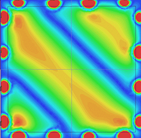Course description:
This course aims to provide students with essential techniques for designing analog electronic circuits at microwave and radio frequencies (RF) for mobile and wireless applications. This course is devoted to lumped and distributed passive circuitry and solid state semiconductor active circuitry. Some topics of coverage include transmission lines, microwave networks, impedance matching, microwave filters, microwave amplifiers, and passive and active microwave components.
Class Size:
15-40 students
My Role:
Instructor (2019-Present)
Course description:
The aim of this course is to provide students with fundamental electromagnetic theories and techniques for working as a communication engineers. Some topics of coverage include Maxwell's equations, plane waves, EM waves in transmission lines, reflection and transmission phenomena, impedance matching and introduction to antennas.
Class Size:
30-60 students
My Role:
Instructor (2019-Present)
Course description:
This is a graduate course introducing students to the field of antennas design and engineering. Coverage includes fundamental antenna parameters, and various types of antennas (incl. dipoles, loops, apertures, printed antennas, IC antennas, metamaterial antennas, arrays and broadband antennas). Mathematical treatments, including integral equations, method of moments, the induced EMF method, the equivalent current method and plane-wave expansion, will also be introduced throughout the course.
Class Size:
Approximately 20 students in lecture
My Role:
Subsititute lecturer (2017)
Course description:
This is a graduate course introducing students to design and analysis techniques for microwave and millimeter wave systems. Coverage includes a review of electromagnetic theory, transmission line theory, impedance engineering, microwave networks, multi-port microwave systems and introductions to waveguides and antennas.
Class Size:
Approximately 15 students in lecture
My Role:
Subsititute lecturer (2016)
Course description:
This is a third year course to Engineering Science students. Coverage includes transmission line theory, Maxwell’s equations, and electromagnetic wave dynamics in free-space, across interfaces and through waveguides.
Class Size:
Approximately 30 students in tutorial
My Role:
Tutor (2011)
My contributions:
- Ran weekly tutorials which reviewed key concepts and explore problem set questions
- Answered student questions
- Devised supplementary course materials
- Contributed to the design of test and exam questions
- Graded and provided feedback on student work
Course description:
This is a third year course to Electrical Engineering students. Coverage includes transmission line theory, Maxwell’s equations, and electromagnetic wave dynamics in free-space, across interfaces and through waveguides.
Class Size:
Tutorial attendance ranged from 10-30 students
Laboratory sessions ranged from 15-20 students
My Role:
Laboratory supervisor (2012), Tutor 2009-2011, 2013), Grader (2007),
Substitute Lecturer (2013-2016)
My contributions:
- Ran weekly tutorials which reviewed key concepts and explore problem set questions
- Answered student questions
- Devised supplementary course materials
- Contributed to the design of test and exam questions
- Ran biweekly laboratory sessions in a microwave lab
- Gave instructions for the laboratory session and brief explanations on relevant key concepts
- Provided laboratory help to small groups of students
- Graded and provided feedback on student work
Course description:
This is a third year course introducing Electrical Engineering students to ray and wave optics. Topics covered include ray propagation through space, lens and mirrors, basic properties of electromagnetic plane waves and dynamics of their propagation and interference, and an introduction to semi-classical optics.
Class Size:
Tutorial attendance ranged from 10-30 students
My Role:
Tutor (2008-2012, 2014)
My contributions:
- Ran weekly tutorials which reviewed key concepts and explore problem set questions
- Answered student questions
- Devised supplementary course materials
- Designed questions for problem sets and tests
- Ran cumulative reviews
- Graded and provided feedback on student work
Course description:
This second year course for Electrical and Computer Engineering students covers electrostatics and magnetostatics. Simplified static forms of Maxwell equations are introduced and applied to simple electromagnetic problems. The laboratory introduces students to computational electromagnetics and finite element methods.
Class Size:
Lab sessions with approximately 50 students
My Role:
Laboratory supervisor (2007)
My contributions:
- Ran biweekly laboratory sessions in a computer lab environment
- Gave explanations and instructions regarding the laboratory
- Provided laboratory help to small groups of students
- Graded and provided feedback on student work
Course description:
This first year Engineering Science course introduces students to linear circuit components (RLC), equivalent networks, phasor formulation and AC analysis.
Class Size:
Lab sessions with attendance ranging from 10 to 40 students
My Role:
Laboratory supervisor (2010)
My contributions:
- Ran biweekly laboratory sessions in an electronics lab
- Gave instructions for the laboratory session and brief explanations on relevant key concepts
- Provided laboratory help to small groups of students
- Graded and provided feedback on student work
